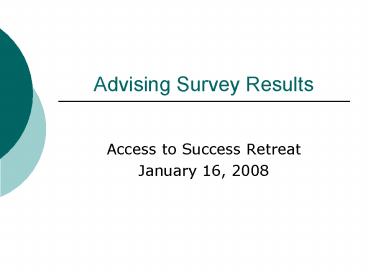Advising Survey Results - PowerPoint PPT Presentation
1 / 17
Title:
Advising Survey Results
Description:
Lori Fitzenberger, College of Letters & Science. Lenore Fuller, College ... Kristin Roosevelt, Lubar School of Business. Andrea Wrench, Lubar School of Business ... – PowerPoint PPT presentation
Number of Views:34
Avg rating:3.0/5.0
Title: Advising Survey Results
1
Advising Survey Results
- Access to Success Retreat
- January 16, 2008
2
Advising Survey Subcommittee
- Linda Anderson-Courtney, Academic Affairs
- Kate Brondino, College of Health Sciences
- Rachel Cocos, Dept. of Curriculum Instruction
- Lori Fitzenberger, College of Letters Science
- Lenore Fuller, College of Letters Science
- Jennie Klumpp, College of Engineering Applied
Science - Rachael Moebius, Lubar School of Business
- Kristin Roosevelt, Lubar School of Business
- Andrea Wrench, Lubar School of Business
- Seth Zlotocha, Dept. of Enrollment Services
3
Background
- Questions designed by academic advisors
endorsed by AAPC - Survey distributed to all undergraduate students
in Spring 2007 - 3,087 respondents
- Raw data shared with deans and advising offices
on campus - Advising Survey Subcommittee organized to review
results - Subcommittee focused on expectations vs.
experiences of student respondents
4
Expectations vs. Experiences
- Students asked to rate their expectations on
eleven statements of services that advisors
provide - Students were then asked to rate their own
experiences with advisors pertaining to the same
eleven statements - Gaps appeared between expectations and experiences
5
Expectations vs. Experiences
- Clearly explain degree, major, minor and/or
certificate requirements - Expectation 99 percent
- Experience 61 percent
- Neutral 17 percent
- Gap w/ Neutral 21 percent
- Gap w/o Neutral 38 percent
6
Expectations vs. Experiences
- Help students learn how to find information about
majors and courses - Expectation 98 percent
- Experience 61 percent
- Neutral 18 percent
- Gap w/ Neutral 19 percent
- Gap w/o Neutral 37 percent
7
Expectations vs. Experiences
- Aid students to create a long-term educational
plan - Expectation 98 percent
- Experience 37 percent
- Neutral 24 percent
- Gap w/ Neutral 37 percent
- Gap w/o Neutral 61 percent
8
Expectations vs. Experiences
- When in a difficult academic situation, help
students understand their choices and what the
consequences will be - Expectation 97 percent
- Experience 30 percent
- Neutral 22 percent
- Gap w/ Neutral 45 percent
- Gap w/o Neutral 67 percent
9
Expectations vs. Experiences
- Provide information about courses but give
students responsibility to choose their own
courses - Expectation 95 percent
- Experience 66 percent
- Neutral 16 percent
- Gap w/ Neutral 13 percent
- Gap w/o Neutral 29 percent
10
Expectations vs. Experiences
- Help students to understand the policies and
procedures of the University, such as add/drop
policies, appeal processes, etc. - Expectation 94 percent
- Experience 39 percent
- Neutral 24 percent
- Gap w/ Neutral 31 percent
- Gap w/o Neutral 55 percent
11
Expectations vs. Experiences
- Help students develop educational goals based
upon their abilities and interests - Expectation 93 percent
- Experience 27 percent
- Neutral 27 percent
- Gap w/ Neutral 39 percent
- Gap w/o Neutral 66 percent
12
Expectations vs. Experiences
- Enable students to understand the value of
working with an advisor - Expectation 84 percent
- Experience 32 percent
- Neutral 27 percent
- Gap w/ Neutral 25 percent
- Gap w/o Neutral 52 percent
13
Expectations vs. Experiences
- Help students find on-campus resources such as
the Norris Health Center, career development
services, tutoring services, etc. - Expectation 82 percent
- Experience 22 percent
- Neutral 21 percent
- Gap w/ Neutral 39 percent
- Gap w/o Neutral 60 percent
14
Expectations vs. Experiences
- Tell students exactly what courses to take for
the next semester - Expectation 71 percent
- Experience 44 percent
- Neutral 21 percent
- Gap w/ Neutral 6 percent
- Gap w/o Neutral 27 percent
15
Expectations vs. Experiences
- Show an interest in student activities outside of
the classroom - Expectation 63 percent
- Experience 23 percent
- Neutral 21 percent
- Gap w/ Neutral 19 percent
- Gap w/o Neutral 40 percent
16
Key Points
- Limited time/contact with students
- Doing well providing basic information to
students - Need to reach students in different ways
- Need to keep advisors informed
- Need for additional advisor professional
development - Need for central hub for information on UWM
website - Not always experiences to match expectations
17
Ideas for Future
- Address advisor caseloads
- Explore new ways to contact students (Facebook,
IM, blogs, etc.) - Easy to find web page devoted to links to common
policies, procedures, campus-wide student
services, etc. - Continue to rollout advisement reports for
students on PAWS - Establish a working group of advisors for next
PAWS upgrade - Re-focus purpose of Advisors and Counselors
Network (ACN) - Continuous and formalized sharing of best
practices between advising offices - Use First Year Center as launching point for
University 101 seminar for students - ???































